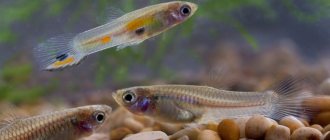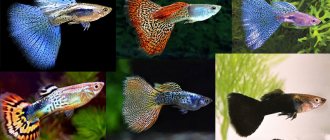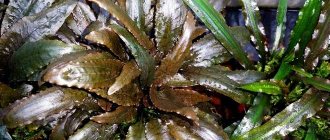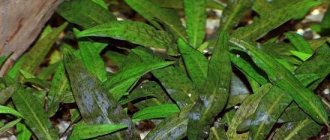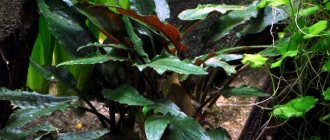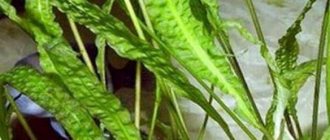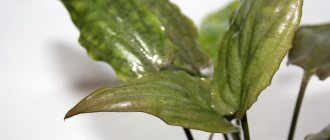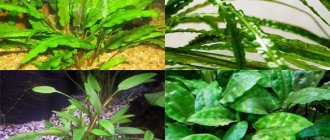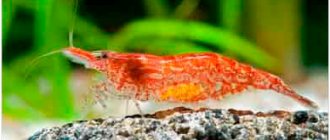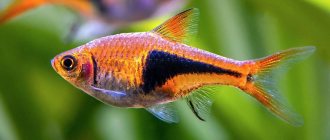Family: Araceae (Araceae).
Origin: Sri Lanka.
Difficulty: Medium.
Conditions: Medium to very strong lighting. Water temperature 20-30°C. KH 2-16°. pH 5.5-8.
Dimensions: Height 5-10 cm. Width 5-7 cm.
Growth rate: Very slow.
Cryptocoryne parva is the smallest of all cryptocorynes, one of the few varieties that do not noticeably change leaf shape and color depending on conditions. Cryptocoryne dwarf is more demanding on lighting conditions and is used by aquaskeepers as a ground cover plant and an accent in the composition. The plant is ideal for planting in the foreground.
Description
The smallest of all known cryptocorynes, parva reaches only 3-10 cm in height and forms a rosette up to 5-8 cm in width. Depending on the cultivation conditions, the shape of the leaves greatly changes. The bright green lanceolate leaves can reach 10 cm in length, depending on the light and amount of nutrients. If there is insufficient lighting, it can completely lose its leaf blade, so it should never be shaded by other plants.
Spreading
Like other close relatives, Cryptocoria Parva grows naturally on the island of Sri Lanka. The climate here is hot, with a lot of sunny days and high humidity. Freshwater bodies of water are located mainly in dense tropical forests, as well as off the coast of the Indian Ocean.
Cryptocoryne grows in a semi-submerged state, periodically flowering, which it can only do on land. Its discovery for the whole world is the merit of the Dutch botanist Hendrik De Wit, who in 1970 described the plant and classified it as a separate species.
Content
Cryptocoryne Parva will not be difficult if you know how to properly care for it. The peculiarity of this species is that it does not change the color or shape of the leaves if the conditions change. The optimal water temperature is 22-27 degrees. Cryptocoryne loves bright light, and if there is not enough light, the leaves will begin to stretch upward towards the light source, the lower leaves will fall off, and their growth will stop. Therefore, Cryptocoryne should not be planted in the shade of other plants.
It must be kept in the light for at least 12 hours a day. The required lighting power is 0.5 W/l. Cryptocoryne is sensitive to water transparency, so you need to regularly monitor the cleanliness of the aquarium and change the water in it weekly. PH is not higher than 5.5–5.8. You should also regularly thin out the bushes to improve water circulation, since if there is poor water flow, the grass will become overgrown with algae, which impairs its health. The only drawback is slow growth (only 5-8 leaves grow per year), but with sufficient care it can be accelerated with the help of CO2 and mineral supplements.
Since Cryptocoryne Parva has an underdeveloped root system, it must be planted in the soil, to which it clings with its roots and is held there. The period of adaptation to a new place of growth can reach up to one month. At this time, you need to especially carefully monitor the plant - remove dead leaves in a timely manner, do not change the level of PH, light, temperature, hardness. This can cause the grass to not adjust to its new environment. You need to plant individual sprouts at a distance of several centimeters from each other. After some time, the bushes will grow so much that they form a dense carpet of grass at the bottom of the aquarium.
Water
The plant grows along the banks of warm tropical reservoirs. This means it needs appropriate water temperature. The minimum temperature must not be lower than 22 °C. Otherwise, the cryptocoryne bushes will begin to get sick and will soon die.
The ideal indicator is in the range from 24 to 28 °C.
Before purchasing, be sure to consider whether this temperature will be comfortable for other inhabitants of the aquarium.
Water hardness should also be no higher than 10 – 11° dGH. Acidity is measured individually. It is important that the indicator is normal.
Care Tips
1) As mineral supplements, you can choose substances containing potassium and magnesium in large quantities. They will increase the rate of growth and development of Cryptocoryne.
2) You should not plant it in deep aquariums, since at great depths the plant grows poorly due to lack of light. The ideal option would be a shallow aquarium or a nano aquarium.
3) Cryptocoryne reproduces using layering that forms on the main shoot. Under no circumstances should a daughter shoot be separated until at least 5 leaves appear on it.
4) Sand or fine gravel can be used as soil.
5) Pieces of peat or clay can be placed under the roots of the plant for additional fixation. Silted soil can be used for the same purpose.
6) Usually the Cryptocoryne carpet spreads horizontally, and if it becomes noticeable that the leaves are raised, then the lighting level needs to be increased.
Cryptocoryne disease
The cause of this disease is a sharp change in some chemical parameters of the water in the aquarium. That is, if the pH suddenly increases, the plant will get sick.
A sign of cryptocoryne disease is the appearance of “slime” on absolutely all the leaves of this plant, which is located in the aquarium. In addition, the leaves become not the most attractive - holes form in them, the edges become uneven.
The plant can be cured if the pH is returned to its original state. Yes, this will not lead to the already formed leaves becoming beautiful again, as before. But new shoots that emerge from the rhizomes will no longer be susceptible to this disease. Naturally, this will happen if the rhizomes themselves are not affected by rotting. To solve the problem with cryptocoryne disease, the aquarist will need to do the following:
- Change the aquarium water and clean the soil from possible contamination.
- Remove damaged rhizomes and rotting leaves to prevent the disease from spreading to surviving specimens.
Aquadesign
Due to its small stature and high light requirements, Cryptocoryne parva is best suited for a well-lit, small/nano aquarium, in the foreground or middle ground. In large and medium-sized aquariums it can be used as ground cover with foreground plants.
If you plant several plants at an equidistant distance, then under favorable conditions you can get a continuous thick carpet in the aquarium. And due to its slow growth, this “carpet” will not require excessive effort to maintain. There are examples of excellent aquatic designs being created using various species of Cryptocoryne, where Cryptocoryne parva is used in the foreground.
How to keep
Keeping Cryptocoryne will not cause much trouble.
- Check temperature, fluid and acidity readings daily.
- This plant loves clean water, so it is recommended to change it in the aquarium once a week by one quarter.
- Before adding new plants, it is recommended to keep them in quarantine for some time. If after two weeks the plants perform well, they are planted in the main aquarium.
- Once a week, cryptocoryne must be fed with appropriate fertilizers that are characteristic of its species.
- If the algae has suffered any illness, almost immediately, it is necessary to urgently separate all the affected parts and also change the water.
Under the right conditions, the plant can delight with its appearance for a long time.
Related (affinity)
Previously, this species was so common that it was simply called cryptocoryne. The external signs of affinis can vary greatly. The size of the leaves depends on the light level. If it is light, then they reach 12 cm. Otherwise, they grow up to 40 cm, but the color becomes much paler.
The leaves are rich green on top with yellow or brown veins. The lower part is red or green. In comfortable keeping, the color on top is dark green and the bottom is burgundy-violet.
Lives in both soft and hard environments. Not picky about changing water. Nutritious soil is not necessary; even simple sand will do. Large pebbles are not desirable for the related affinis, because it will be difficult for the plant’s bush to grow.
Priming
The main criterion for good growth of Cryptocoryne yellow is the siltation of the soil. In poor soil, the plant develops slowly and does not reach the specified size. When planting in new soil, lumps of clay or a mixture of clay and peat should be placed under the roots. Coarse sand or small pebbles are suitable as a substrate; It is recommended to avoid the use of large pebbles, since basal suckers developing close to the mother plant can interfere with its growth. The soil must be laid in a large layer of at least 5 cm. Growth is well influenced by mineral fertilizing of cryptocoryne, the basis of which should be nitrogen and microelements. However, in well-silted soil, additional fertilizing is usually not required.
It is important to note that the soil should not bubble - in highly acidic soil, the roots of Cryptocoryne yellows die off. Periodically twitching the cryptocoryne rosette a couple of centimeters and loosening the soil has a good effect on the root system.
Reproduction
Cryptocorynes reproduce vegetatively - by root suckers and rhizomes, and much less often - by seeds. Root cuttings are separated after they reach half the size of the mother plant. The creeping shoot on which they form is cut. Some plant species grow rather slowly; to speed up the process of their reproduction, all leaves are removed from the bush, leaving the rhizome to float on the surface of the water. Daughter plants should form in 1-3 weeks. The rhizomes are cut when their leaves reach 4-5 cm, and the plants are planted in the ground.
Cryptocoryne purpurea
Genus: Cryptocoryne.
Family: Araceae.
Other names: K. Griffith's plant, Cryptocoryne cordate. Depending on the conditions of its maintenance, the plant changes greatly in appearance, so confusion often arises in determining the species.
Habitat: Malaysia.
Appearance: herbaceous bush about 40 cm high. The plant has long oval leaves, collected in a rosette. The leaf plate on the front side is in various shades of green, and on the inside there are many variations of red.
Root system: well developed.
Soil: nutritious, heavily silted, at least 7 cm thick. The composition of the substrate does not matter, since the plant has a powerful root system. When planting Cryptocoryne, clay should be added to the bottom of the hole, adding peat or silt from another aquarium. Periodically, the plant should be fed with mineral fertilizers.
Lighting: Cryptocoryne cordate is not demanding on lighting; natural light is enough for her, and even in the shade she can feel absolutely comfortable. But this does not mean at all that the plant will delight you with its excellent appearance; it will become pale and elongated. It will be much better if Cryptocoryne is provided with good artificial lighting. To do this, you will need fluorescent lamps of the LD and LB type with a power of 0.3-0.4 W / 1 l or incandescent lamps - approximately 1 W / 1 l.
Water parameters:
Comfortable temperature: 24-26 °C, although 20-28 °C is acceptable. When the water temperature drops, the plant's growth slows down.
“Acidity” Ph: slightly acidic or neutral.
Hardness dH: low, 2-10°. As hardness increases, the plant becomes smaller.
Cryptocoryne purpurea is almost not afraid of changing water, only in very bad conditions does it shed its leaves. People rarely get sick with cryptocoryne disease.
The plant feels good in old water; after changing it, it does not grow for some time.
Placement in the aquarium: in the center of the aquarium or in the background near the side walls.
Reproduction: vegetative, root layering.
In a humid greenhouse, Cryptocoryne cordate develops more actively. The plant is transferred to a less humid environment gradually; the water level decreases evenly with the appearance of young leaves. When Cryptocoryne is happy with everything, it grows and blooms quickly.
If you take a plant from a paludarium, then it can be placed in an aquarium without adaptation.
Cryptocoryne aquarium background
Cryptocoryne blassa,
from the Malay Peninsula, has large round leaves, an olive green top and a beet red base making it a desirable centerpiece of the aquarium.
It may take several weeks or even months after planting to see the plant in its full glory. Blassa can adapt to hard water, but it is better to keep it in a soft, slightly acidic environment. Cryptocoryne Crispatula
from India and Thailand is considered a variant of Cryptocoryne Balance.
Cryptocoryne ciliata,
from India and New Guinea, is a well-established aquarium plant in both freshwater and brackish aquariums. Strong light allows the plant to grow at a reasonable rate. Feels great above water in paludariums.
Cryptocoryne usteriana
, from the Philippines, is attractive because it grows well in hard water without much effort or care. Usteriana can grow quite large leaves floating on the surface of the water. Typically, the leaves are dark green on the upper side with a dark red underside that stands out. The hybrid plants developed in Germany have red coloring on both sides of the leaves. Cryptocoryne usteriana grows quickly and easily propagates by shoots. One healthy plant can produce several new ones throughout the year. If the aquarist is patient with these plants and is willing to give them time to establish themselves in the home pond, Cryptocorynes will not disappoint. However, the modern aquascaper, constantly replanting plants, will probably be disappointed with Cryptocoryne, and yet: Pictures are clickable
tell friends
COMMENTS ON THE TOPIC
Balance
Cryptocoryne's balance sheet has a number of variations. Balance became famous for her capricious behavior and gentle beauty. If the basic requirements are met, cryptocoryne balance will reward the owner with lush greenery of emerald color. The leaves of the balance are lanceolate up to 50 cm, sometimes green and brown. Cryptocoryne balance has a horizontally located rhizome, on which there is a rosette of narrow leaves.
Balance is planted in a tall aquarium and grows up to 60 cm. Cryptocoryne balance is demanding of high-quality substrate.
Balance loves the bright diffused light of fluorescent lamps. Propagated by root layering with 4-5 leaves. The balance needs to be provided with aeration. To equip the roots with heating, you can install a bottom filter that draws water down.
Features of the plant
Cryptocoryne is a bush with an extensive root system. Its height depends on the species and natural conditions and ranges from 4 to 100 cm. Giant cryptocoryne grows up to 130 cm.
From 5 to 15 leaves grow from one hydrophyte root. Their shape is varied: from lanceolate to oval. The surface of the leaves is smooth or pimpled. The colors are also varied: all sorts of shades of green, brownish and red. The name of the plant consists of two parts:
- "crypto" in Latin means "hidden";
- "koryne" means "cob" in Greek.
This is due to the fact that there is a small spadix inside the Cryptocoryne flower. The flower itself is shaped like a flute. Cryptocoryne rarely blooms in aquarium conditions. It is very difficult to achieve its flowering. Usually, aquarium owners only have to admire the beautiful leaves of the plant.
Habitat of the snapping turtle
Cayman turtle photo
The snapping turtle is native to North America, namely the southeastern regions of Canada, as well as the eastern regions of the United States. In nature, it lives in various freshwater bodies of water: rivers, lakes, ponds. Prefers places with a high silt content so that it can burrow easily. In the cold season, from October to March, it hibernates, burrowing into the muddy bottom. This species of turtle has a wide temperature tolerance limit. For local residents, a reptile swimming under the ice crust is not an uncommon sight. The snapping turtle can be found in the semi-deserts of Texas and even in the Rocky Mountains at an altitude of more than one and a half kilometers.
The Cayman “Tortilla” is a completely aquatic animal; as a rule, it comes to land to change the reservoir or for the female to lay eggs.
